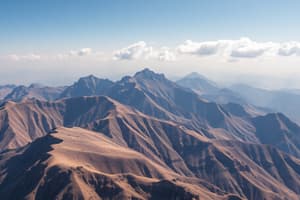Podcast
Questions and Answers
What does physical geography primarily study?
What does physical geography primarily study?
- Natural features such as landforms and climate (correct)
- Human cultures and societal structures
- Economic activities and trade patterns
- Population distributions and demographics
Which term refers to the characteristics that define a location?
Which term refers to the characteristics that define a location?
- Location
- Region
- Environment
- Place (correct)
What are the main components of human geography?
What are the main components of human geography?
- Cultural practices, languages, and economic activities (correct)
- Landforms such as mountains and valleys
- Weather patterns and climate zones
- Biomes like forests and deserts
Which of the following is NOT part of spatial concepts?
Which of the following is NOT part of spatial concepts?
What type of map would best represent physical features such as mountains and rivers?
What type of map would best represent physical features such as mountains and rivers?
Which of the following is an example of environmental interaction?
Which of the following is an example of environmental interaction?
What does the term 'urbanization' refer to?
What does the term 'urbanization' refer to?
What is the significance of climate change in geography?
What is the significance of climate change in geography?
Which feature is essential for interpreting maps?
Which feature is essential for interpreting maps?
What do economic geographers primarily analyze?
What do economic geographers primarily analyze?
Study Notes
Geography in Social Studies
-
Definition: Geography is the study of the Earth’s landscapes, environments, and the relationships between people and their environments.
-
Key Concepts:
-
Physical Geography: Focuses on natural features (landforms, climate, ecosystems).
- Landforms: Mountains, valleys, plains, plateaus.
- Climate: Regional climates (tropical, temperate, polar) and their impact on human activities.
- Ecosystems: Interaction of living organisms with their environment (biomes like forests, deserts, wetlands).
-
Human Geography: Examines human activities, cultures, and their spatial relationships.
- Population Geography: Studies population distributions, densities, and growth patterns.
- Cultural Geography: Focuses on cultural practices, languages, religions, and traditions within different regions.
- Economic Geography: Analyzes how economic activities (trade, agriculture, industry) are distributed.
-
-
Spatial Concepts:
- Location: Absolute (exact coordinates) vs. relative (location in relation to other places).
- Place: Characteristics that define a location (physical and human attributes).
- Region: Areas defined by common features (formal, functional, and perceptual regions).
- Movement: How people, goods, and ideas travel from one location to another.
- Human-Environment Interaction: How humans adapt to and modify their environments.
-
Map Skills:
- Types of Maps: Political, physical, thematic, and topographic maps.
- Map Elements: Scale, legend, compass rose, and grid systems.
- Interpreting Maps: Understanding symbols, reading coordinates, and analyzing spatial data.
-
Global Issues:
- Sustainability: Importance of conserving natural resources and protecting ecosystems.
- Urbanization: Growth of cities and the challenges it presents (overcrowding, pollution).
- Climate Change: Impact on geography (rising sea levels, changes in weather patterns).
-
Geographic Tools:
- GIS (Geographic Information Systems): Technology for analyzing spatial data.
- Remote Sensing: Collecting data from satellites for environmental monitoring.
- GPS (Global Positioning System): Technology for determining precise locations on Earth.
-
Cultural Interactions:
- Globalization: Increased interconnectedness of economies and cultures.
- Migration: Movement of people and its effects on society and culture.
- Cultural Diffusion: Spread of cultural beliefs and practices from one society to another.
This summary provides a foundational understanding of geography within social studies, illustrating its multifaceted nature and importance in understanding both the physical and human worlds.
Geography in Social Studies
- Geography studies Earth's landscapes, environments, and human-environment relationships.
- Divided into two main branches: Physical Geography and Human Geography.
Physical Geography
- Focuses on natural features, including:
- Landforms: Includes mountains, valleys, plains, and plateaus.
- Climate: Examines tropical, temperate, and polar climates and their effects on human activities.
- Ecosystems: Analyzes interactions between organisms and their environments (e.g. forests, deserts, wetlands).
Human Geography
- Explores human activities and cultural differences:
- Population Geography: Looks at population distributions, densities, and growth trends.
- Cultural Geography: Investigates languages, religions, and cultural practices in various regions.
- Economic Geography: Studies the distribution of economic activities such as trade, agriculture, and industry.
Spatial Concepts
- Location: Differentiates between absolute (exact coordinates) and relative (comparison to other locations) locations.
- Place: Defines locations based on physical and human characteristics.
- Region: Identifies areas based on common features; types include formal, functional, and perceptual regions.
- Movement: Examines the mobility of people, goods, and ideas.
- Human-Environment Interaction: Explores how humans adapt to and modify their environments.
Map Skills
- Types of Maps: Includes political, physical, thematic, and topographic maps.
- Map Elements: Essential components such as scale, legend, compass rose, and grid systems.
- Interpreting Maps: Skills in understanding symbols, reading coordinates, and analyzing spatial data.
Global Issues
- Sustainability: Highlights the importance of conserving natural resources and protecting ecosystems.
- Urbanization: Discusses city growth and challenges like overcrowding and pollution.
- Climate Change: Examines its geographic impacts, including rising sea levels and weather pattern alterations.
Geographic Tools
- GIS (Geographic Information Systems): Technology for analyzing and visualizing spatial data.
- Remote Sensing: Involves gathering data from satellites for environmental assessments.
- GPS (Global Positioning System): Provides precise location tracking on Earth.
Cultural Interactions
- Globalization: Describes the growing interconnectedness of global economies and cultures.
- Migration: Examines the impact of human movement on society and culture.
- Cultural Diffusion: Investigates how cultural beliefs and practices spread between societies.
Studying That Suits You
Use AI to generate personalized quizzes and flashcards to suit your learning preferences.
Description
Explore the essential concepts of geography within social studies, covering both physical and human geography. Understand landforms, climate, ecosystems, and the impact of human activities and cultures on the environment. This quiz will challenge your knowledge on how geography shapes our world.




